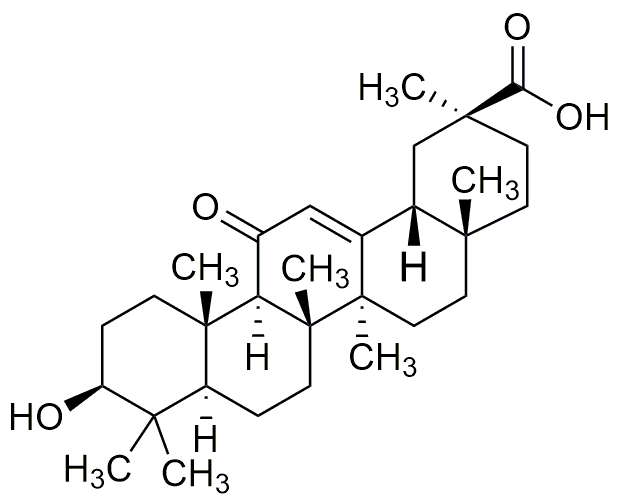Glycyrrhetic acid is widely utilized in research focused on:
- Pharmaceuticals: Known for its anti-inflammatory and antiviral properties, it is often used in the formulation of topical creams and ointments for skin conditions such as eczema and psoriasis.
- Cosmetics: This compound is a popular ingredient in skincare products due to its ability to soothe and hydrate the skin, making it effective in anti-aging and moisturizing formulations.
- Food Industry: Glycyrrhetic acid is used as a natural sweetener and flavor enhancer in various food products, offering a healthier alternative to synthetic sweeteners.
- Herbal Medicine: It is commonly found in traditional herbal remedies, particularly in licorice extracts, where it is valued for its potential health benefits, including digestive support.
- Research and Development: The compound is a subject of ongoing studies for its potential therapeutic effects against various diseases, including cancer and metabolic disorders, making it a valuable resource for researchers.
General Information
Properties
Safety and Regulations
Applications
Glycyrrhetic acid is widely utilized in research focused on:
- Pharmaceuticals: Known for its anti-inflammatory and antiviral properties, it is often used in the formulation of topical creams and ointments for skin conditions such as eczema and psoriasis.
- Cosmetics: This compound is a popular ingredient in skincare products due to its ability to soothe and hydrate the skin, making it effective in anti-aging and moisturizing formulations.
- Food Industry: Glycyrrhetic acid is used as a natural sweetener and flavor enhancer in various food products, offering a healthier alternative to synthetic sweeteners.
- Herbal Medicine: It is commonly found in traditional herbal remedies, particularly in licorice extracts, where it is valued for its potential health benefits, including digestive support.
- Research and Development: The compound is a subject of ongoing studies for its potential therapeutic effects against various diseases, including cancer and metabolic disorders, making it a valuable resource for researchers.
Documents
Safety Data Sheets (SDS)
The SDS provides comprehensive safety information on handling, storage, and disposal of the product.
Product Specification (PS)
The PS provides a comprehensive breakdown of the product’s properties, including chemical composition, physical state, purity, and storage requirements. It also details acceptable quality ranges and the product's intended applications.
Certificates of Analysis (COA)
Search for Certificates of Analysis (COA) by entering the products Lot Number. Lot and Batch Numbers can be found on a product’s label following the words ‘Lot’ or ‘Batch’.
*Catalog Number
*Lot Number
Certificates Of Origin (COO)
This COO confirms the country where the product was manufactured, and also details the materials and components used in it and whether it is derived from natural, synthetic, or other specific sources. This certificate may be required for customs, trade, and regulatory compliance.
*Catalog Number
*Lot Number
Safety Data Sheets (SDS)
The SDS provides comprehensive safety information on handling, storage, and disposal of the product.
DownloadProduct Specification (PS)
The PS provides a comprehensive breakdown of the product’s properties, including chemical composition, physical state, purity, and storage requirements. It also details acceptable quality ranges and the product's intended applications.
DownloadCertificates of Analysis (COA)
Search for Certificates of Analysis (COA) by entering the products Lot Number. Lot and Batch Numbers can be found on a product’s label following the words ‘Lot’ or ‘Batch’.
*Catalog Number
*Lot Number
Certificates Of Origin (COO)
This COO confirms the country where the product was manufactured, and also details the materials and components used in it and whether it is derived from natural, synthetic, or other specific sources. This certificate may be required for customs, trade, and regulatory compliance.


